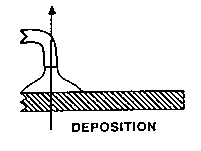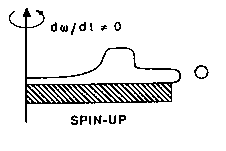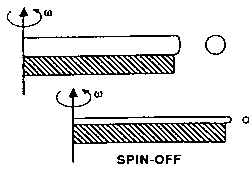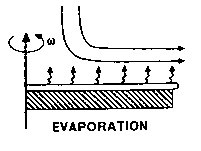The Key Stages in Spin Coating
Although different authors sometimes count things differently,
there are four distinct stages to the spin coating process. Stage 3 (flow
controlled) and Stage 4 (evaporation controlled) are the two stages that
have the most impact on final coating thickness.
 Stage
One: The first stage is the deposition of the
coating fluid onto the wafer or substrate.
Stage
One: The first stage is the deposition of the
coating fluid onto the wafer or substrate.
It can be done using a nozzle that pours the coating solution out, or it could be sprayed onto the surface, etc. Usually this dispense stage provides a substantial excess of coating solution compared to the amount that will ultimately be required in the final coating thickness. For many solutions it is often beneficial to dispense through a sub micron sized filter to eliminate particles that could lead to flaws. Another potentially important issue is whether the solution wets the surface completely during this dispense stage. If not, then incomplete coverage can result.
 Stage
Two: The second stage is when the substrate is
accelerated up to its final, desired, rotation speed.
Stage
Two: The second stage is when the substrate is
accelerated up to its final, desired, rotation speed.
This stage is usually characterized by aggressive fluid expulsion from the wafer surface by the rotational motion. Because of the initial depth of fluid on the wafer surface, spiral vortices may briefly be present during this stage; these would form as a result of the twisting motion caused by the inertia that the top of the fluid layer exerts while the wafer below rotates faster and faster. Eventually, the fluid is thin enough to be completely co-rotating with the wafer and any evidence of fluid thickness differences is gone. Ultimately, the wafer reaches its desired speed and the fluid is thin enough that the viscous shear drag exactly balances the rotational accelerations.
 Stage
Three: The third stage is when the substrate is
spinning at a constant rate and fluid viscous forces dominate fluid
thinning behavior.
Stage
Three: The third stage is when the substrate is
spinning at a constant rate and fluid viscous forces dominate fluid
thinning behavior.
This stage is characterized by gradual fluid thinning. Fluid thinning is generally quite uniform, though with solutions containing volatile solvents, it is often possible to see interference colors "spinning off", and doing so progressively more slowly as the coating thickness is reduced. Edge effects are often seen because the fluid flows uniformly outward, but must form droplets at the edge to be flung off. Thus, depending on the surface tension, viscosity, rotation rate, etc., there may be a small bead of coating thickness difference around the rim of the final wafer. Mathematical treatments of the flow behavior show that if the liquid exhibits Newtonian viscosity (i.e. is linear) and if the fluid thickness is initially uniform across the wafer (albeit rather thick), then the fluid thickness profile at any following time will also be uniform --- leading to a uniform final coating (under ideal circumstances).
 Stage
Four: The fourth stage is when the substrate is
spinning at a constant rate and solvent evaporation dominates the
coating thinning behavior.
Stage
Four: The fourth stage is when the substrate is
spinning at a constant rate and solvent evaporation dominates the
coating thinning behavior.
As the prior stage advances, the fluid thickness reaches a point where the viscosity effects yield only rather minor net fluid flow. At this point, the evaporation of any volatile solvent species will become the dominant process occurring in the coating. In fact, at this point the coating effectively "gels" because as these solvents are removed the viscosity of the remaining solution will likely rise -- effectively freezing the coating in place. (This behavior was used in the seminal work of Meyerhofer (J. Appl. Phys. 49 (1978) 3993) where he quantified the coating thickness dependence on spin speed and viscosity and its relationship to the evaporation rate.)
After spinning is stopped many applications require that heat treatment or "firing" of the coating be performed (as for "spin-on-glass" or sol-gel coatings). On the other hand, photoresists usually undergo other processes, depending on the desired application/use.
Clearly stages 3 and 4 describe two processes that must be occurring simultaneously throughout all times (viscous flow and evaporation). However, at an engineering level the viscous flow effects dominate early on while the evaporation processes dominate later.